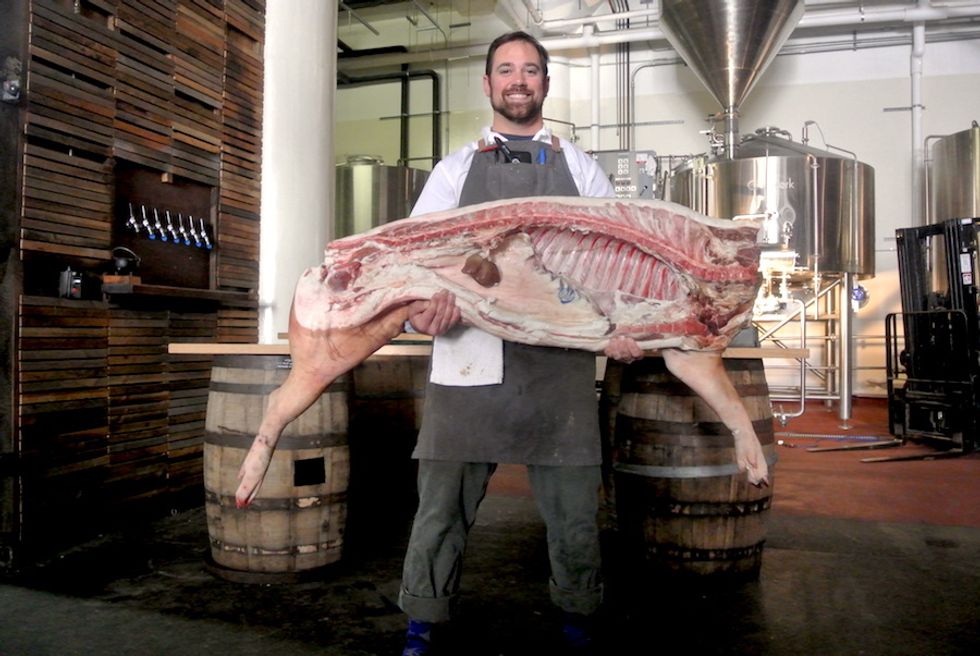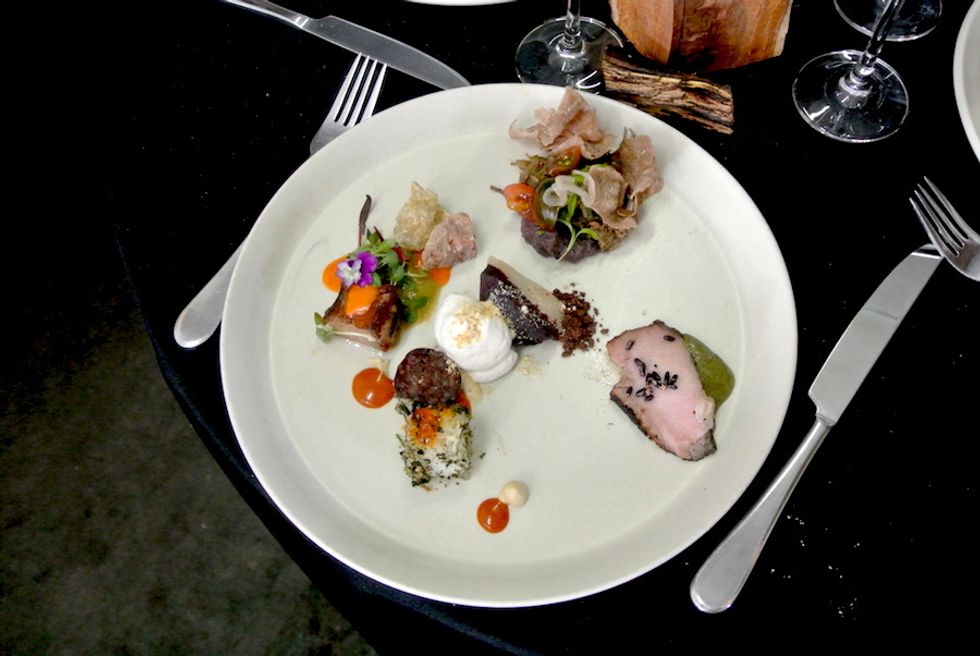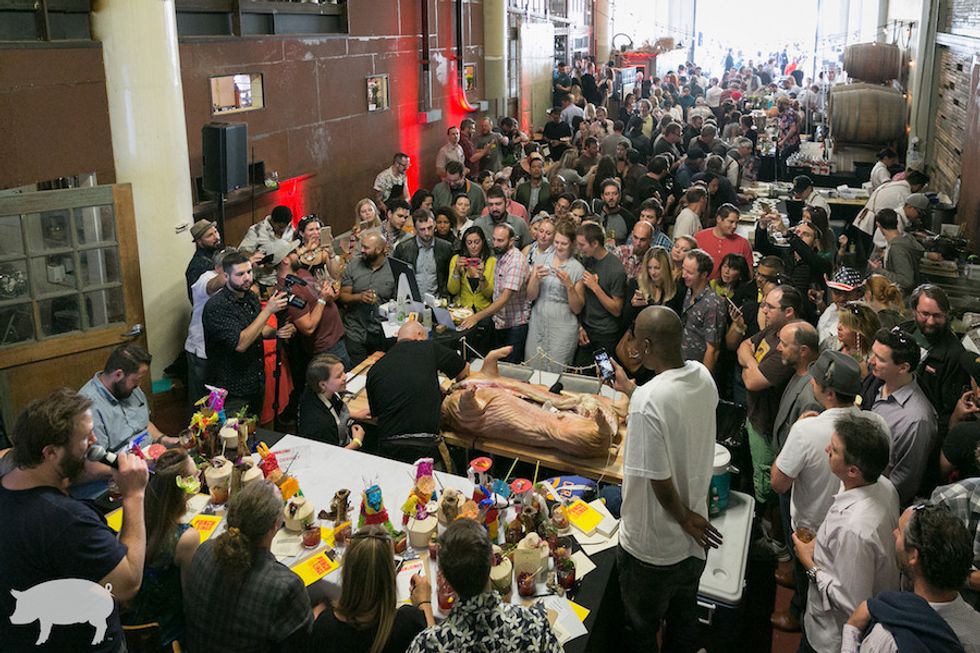"How's Harriet?" I asked, a week before the Cochon555 Heritage BBQ competition, at Smokestack last Sunday.
"Pretty good, considering," responded Smokestack's executive chef, Eric Nyeste. "I mean, last week, she lost her head, and just yesterday, she fell to pieces."

Harriet is, or was, a heritage breed pig who weighed 320 pounds when she started the transition from farm to table. Raised humanely at Devil's Gulch Ranch in Nicasio, the Red Wattle sow pigged out for eight months on whole milk, organic sprouted wheat bread from Petaluma's Alvarado Street Bakery, tortillas from a Santa Rosa tortilleria, unused produce from local food banks, and spent grain from Fort Point and Magnolia breweries before ending up in Nyeste's walk-in cooler for the annual farm-to-table, snout-to-tail competition.
Nyeste was one of five local chefs who each received a heritage pig, along with a challenge to create a snout-to-tail menu to be judged by hand-picked experts and devoured by hundreds of hungry diners, who are allowed inside the venue to graze only after the judging is complete. The winner from each event on the 14-city tour will compete in the national Grand Cochon on October 1 in Chicago. Proceeds from the event benefit the Piggy Bank, an open-access agriculture project for emerging farmers looking to raise heritage breed pigs.
Harriet, known on the farm as 7006, arrived in two halves a week ahead of the big event, which gave Nyeste and his six-member team the opportunity to butcher the meat to their own specifications. He explained, "A chef will often break down a pig differently than a butcher would," because the menu dictates how a chef will butcher an animal, rather than what sells best in the meat case. Because Harriet's breed is known for its rich, beefy flavor, Nyeste's team decided to make charred ribeye, which they served with trotter-tater salad, bacon-onion jam, and green onion ribbons. That meant "...making the saddle cut further up into the shoulder for the more marbled rib-eye meat."
Other items on Smokestack's Heritage BBQ menu were inspired by the heritage of the team members themselves. The beer brat crepinette—served with soft pretzel, cherry mostarda and a New Speedway Bitter from Magnolia—tapped into a team member's Midwestern roots. Nyeste's own Southern upbringing inspired the pork fat Johnny cake, topped with chopped pork, peach salsa, and collard greens.
The cabeza pibil and manteca tortilla—served with salsa verde, cotija, pickled onions and chicharron—relied on the tastes and traditions of team members from Guatemala and Mexico. In fact, Nyeste procured Oaxacan-grown heritage corn in honor of Smokestack team member Maria Tavira, who hails from the nearby Mexican state of Michoacan, to nixtamalize into hand-made masa for the tortillas.
"This menu tells the story of the people making it," he said.
On Sunday, he shared that story with 24 judges who crowded around each restaurant's long table for a brief chef's description of the six dishes before savoring them, scoring them, and moving on to the next table.
"I am Eric Nyeste, chef of the Smokestack and leader of its crew. We have assembled a brief anthology of our stories for you today. In six parts, we invite you to join us on an adventure of six cooks, one fire-breathing kitchen, and our four-legged champion, the humble and much honored Harriet, of Devil's Gulch Ranch."
Harriet sounded better than 7006.
"Our heritage pig is of the Red Wattle breed: stout and beautifully muscled, with some of the most gorgeous fat caps I have had the pleasure of working with. The flesh has a deep red hue and a strong flavor of beef, which we have attempted to apply to our menu to great effect with dishes like the ribeye and bratwurst. That said, she performed beautifully in a more traditional porcine role as well, delivering succulent belly, unctuous trotters and collar, and hams for days and days (of curing and smoking)." He went on to describe each dish individually, as did the other competing chefs, each in turn, as the judges nibbled thoughtfully and took notes.
Chef Trevor Ogden and his team from Park Tavern laid out a round-the-world sampling of barbecue styles, including barbacoa, calcotada, Lexington (North Carolina), Korean, hibachi, and Texan. The Piccino team, led by chef Chandler Diehl, broke down their menu by body parts, with dishes featuring the head, belly, leg, butt, loin, and lard. Chef Tommy Halvorson's crew from Serpentine compiled a diverse sampling of dishes ranging from dwaeji bulgogi with kimchee, hickory smoked ribs with molasses and brown sugar, and sweet tea spiked with mezcal and fat-washed bourbon. Chef Jordan Keao's Aina team remained true to the restaurant's Hawaiian roots, representing two styles of barbecue from the islands: kalua, which requires an underground oven, and hibachi, which is cooked over a wood fire.

Harriet was delicious, but not quite delectable enough to win the competition. She was edged out by a Large Black barrow (castrated male), raised by Wendy Massa and her five-year-old son on their family farm, Massa Natural Meats, near Chico. The rare breed is known for its high quality, marbled meat, as well as its suitability for pasture, rather than confinement. Beyond that, the breed has a "very sweet disposition," according to Massa. "Our biggest sow weighs 500 pounds, and she'll lay down on her side so I can scratch her belly."
Their docile nature was one of the reasons she chose the breed to raise. "My son needs to be able to fill the trough with water without getting knocked over, and I need them to wait for me to feed them, instead of rushing me when I bring the food."
Massa's pig was reared on broken rice, broken almond nuts and shells, prunes, olives, sunflower seeds, and whatever else is plentiful during a given season. He was never fed corn or soy, and the farm does not use growth hormones or routine antibiotics. At 10 months, he was slaughtered and shipped whole to Aina, where Keao and his team transformed him into this award-winning menu:
- Kalua pork belly pozole with smoked headcheese, chicharrones, pickled cabbage
- Korean-style blood sausage with rice onigiri, pork furikake, caramelized onion soubise
- Binchotan grilled char siu pork with charred garlic chive puree, puffed forbidden rice
- Lau lau with paiai: pa'iai, lu'au leaves, hopi blue polenta
- Chichi dango: coconut & blood mochi, kinako lard crumble, smoke haupia whip
While his team did not name their pig, Keao said, "We are very respectful of the fact that we took an animal's life. Our biggest form of respect is to use every part of that animal, including the skin, offal, and blood. Everyone loves loin, belly, and leg, but heart, kidneys and lungs are more challenging. We like to figure out ways to highlight those parts so people don't necessarily know they're eating them until they've already fallen in love with the dish."
Apparently, the judges fell in love. Or perhaps they were simply in hog heaven.






















